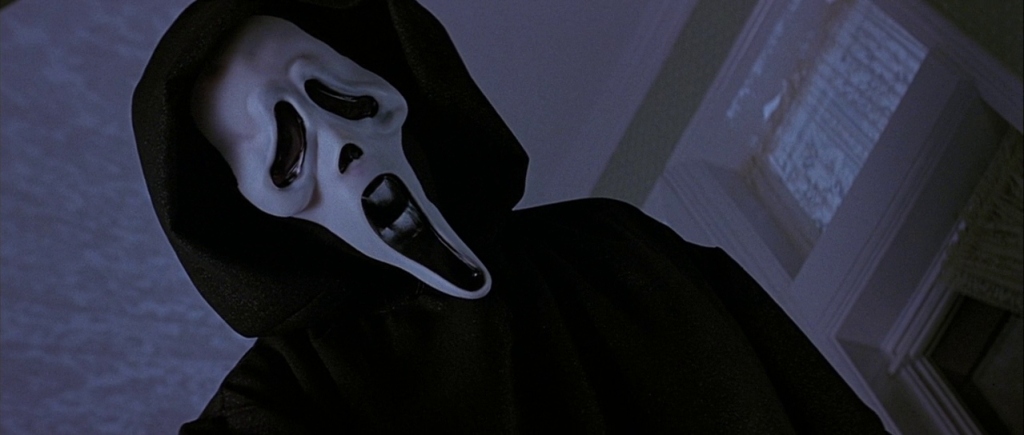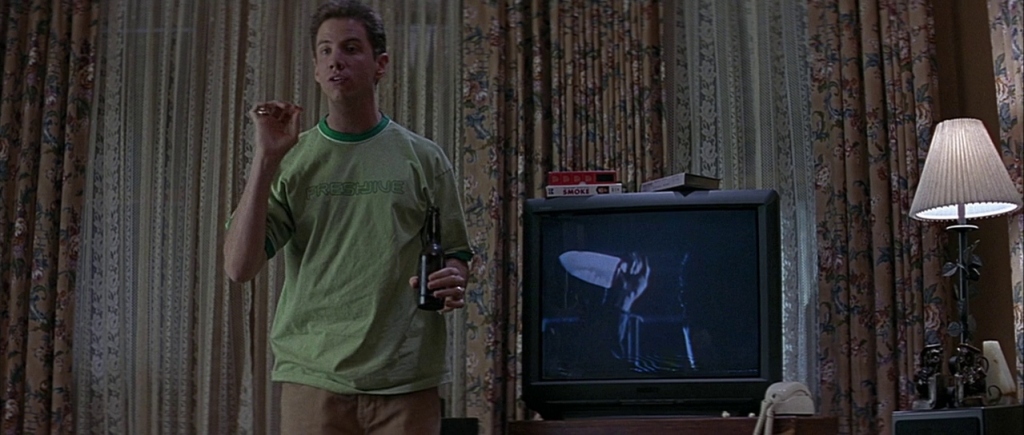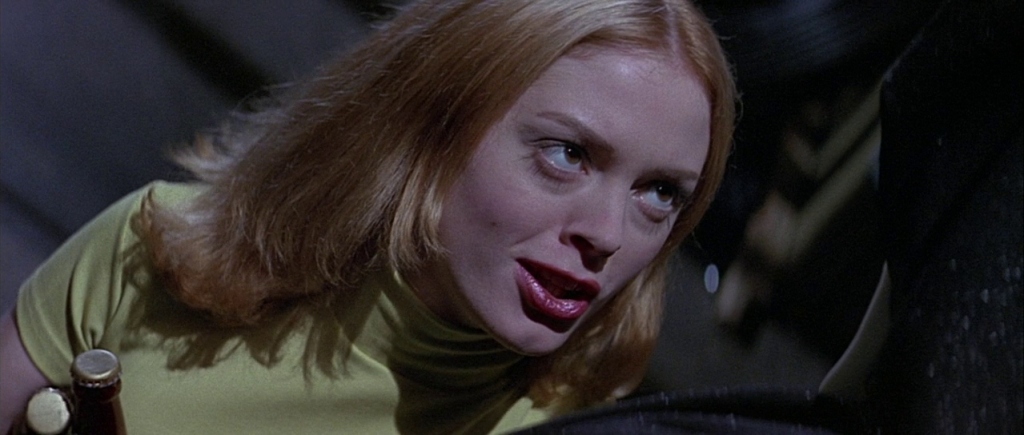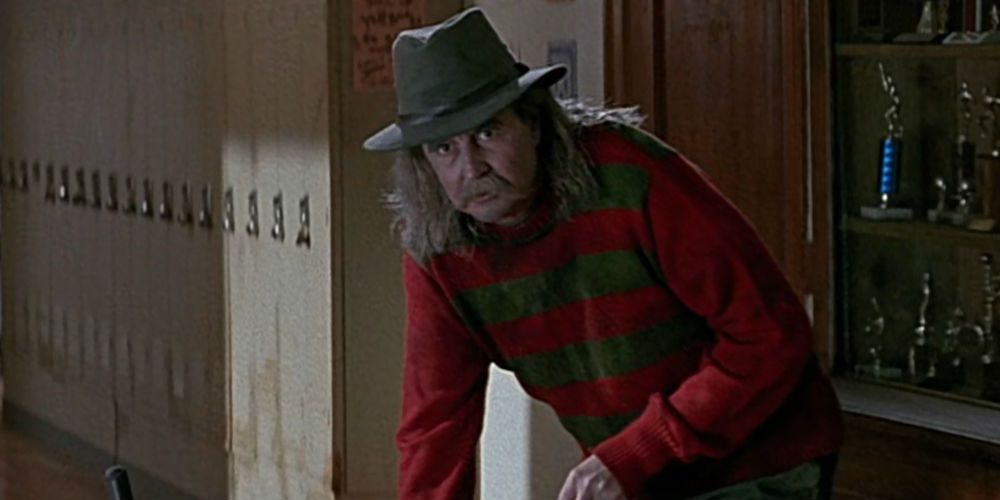Scream (1996), written by Kevin Williamson and directed by the late Wes Craven, is an iconic American meta slasher film, starring Neve Campbell, David Arquette, Courteney Cox, Skeet Ulrich, Matthew Lillard, Jamie Kennedy, Rose McGowan and Drew Barrymore. It follows Sidney Prescott (Campbell), living in the fictional town of Woodsboro, and is set a year after the murder of her mother, and she is terrorized by a killer, by the name of Ghostface, who is targeting her and her friends by using previous horror films as their inspiration, (IMDb) using phone calls to terrorize their victims, asking an array of questions to scare them, their most common one being “what’s your favourite scary movie?” and quizzing them on horror film trivia. Scream can also be categorised into both a black comedy and a whodunit slasher film, using previously seen cliches of the horror movie genre which have also been seen in other iconic slasher movies such as Friday the 13th (1980, dir. Sean S. Cunningham) and Halloween (1978, dir. John Carpenter), as well as another Wes Craven movie, A Nightmare on Elm Street (1984).
Postmodernism is a philosophical movement that has impacted both the arts and critical thinking throughout the later years of the 20th century. Instead of typical narratives, postmodern films tend to stray away from those narratives and adopt attitudes of rejection and irony as well as other characteristics such as; pastiche, hyperreality, intertextuality, unpredictability as well as themes of paranoia, to name a few. Postmodern movies typically criticize long known and previously used cliches and they tend to subvert highly regarded expectations and tamper with and switch up the expected narrative of a horror movie, (Bedard, 2020) but it is important to point out that while the franchise pokes fun at itself, it knows that it has to follow a certain set of rules in order to be somewhat successful.

At the time of its release, Scream was labelled as unique due to the fact that the characters in the movie were actually aware of the real world and the horror movies that came before, as well as the fact that they often discuss the cliches that tend to come with horror movies. The film did a fantastic job at revitalizing the already famous horror genre when it was released in the 1990s, as the genre seemed to be dying out at the time as most horror movies were made and released directly to video, and the franchise as a whole exploited cliches that films of the horror genre were always so reliant on. It could be argued that this is where ‘the rules’ come into play, which is an example of the film’s self-reflexivity, essentially making reference to other, already existing texts, particularly other teen slasher films previously mentioned. Randy Meeks (Kennedy) is probably the film’s most important, meta character, meta cinema being a mode of filmmaking that is used to inform audience’s that they are watching things happen in a fictional world, with regular references to the real world. (Ames, 1997) In the clip where he is explaining the rules to surviving a horror movie, he lists things that almost every character in a horror movie participates in doing before they eventually meet their untimely demise.

Randy is the typical movie buff in this movie, knowing all there is to know about horror movies, and he knows the typical, expected narrative of these movies that Scream has done so well in subverting. Kennedy’s character acts as a narrative device on his own and explains the components of horror films while the group are watching Halloween at Stu’s (Lillard) party, he is an expert when it comes to the genre, but what is ironic is that these rules he is teaching to others, are happening around him as he is explaining the rules, resulted in him being booed by fellow party goers. Another important ‘rule’ that Randy mentions at the end of the film is that “supposedly dead killer comes back to life for one last scare”, which the killer does before they are shot in the head, the only way to really make sure that they are dead and stay dead.
Postmodern movies tend to show a different narrative to a movie than what is necessarily expected, and in the 1990s, postmodernism was used, generally, to poke fun at already existing movies in any genre, not only those that are horror, and this can also be labelled as a parody, and Scream managed to make this work well as it revitalized the entire genre. Scream is a film that has clearly taken into consideration that viewers will have had previous experience with horror movies, allowing audiences to comment on its predictability and also offering a new example of the horror genre at the same time.

Wes Craven has directed this film in a way that manipulates the original script in a way that mocks the typical horror genre in a humorous manner. He has managed to break and play on the rules of the horror genre and make it almost parodic. Rose McGowan’s character, Tatum Riley, Sidney’s best friend, can be used as a good example of this. In the scene when she is in the garage, when she says to the killer, “can I be the helpless victim? Please don’t kill me, Mr. Ghostface, I wanna be in the sequel”, is an example of the protagonists being ironically self aware, almost as if they know that they are in a movie, which is an example of Craven bringing humor into the movie. Irony is also a much used convention used in postmodern films, which is quite regularly played on in Scream.
Scream has a number of postmodern intertextual references to other horror movies, Halloween being the most prominent, as that is the movie that they are watching on the television, and the use of these texts is what fleshes out the film’s postmodernism self awareness. The writer of the movie, Kevin Williamson, has set up Randy to be the film’s horror movie buff who is continuously connecting everything back to the slasher movies that he has watched, giving him his own formula of survival previously mentioned. He also mentions that “if the cops saw Prom Night (1980) they’d know exactly what’s going on!” which is only one of many intertextual references that appear throughout the film. Valerie Wee (2005) points out that the use of intertextuality reflects an already firmly established postmodern trope, but it occurs to such an extent in Scream that it becomes the film’s own text. Its uniqueness arises from the fact that even as it is composed of fragments of previous texts, these are reframed to generate a set of revised aesthetic and narrative characteristics for the genre which in turn provide a template for subsequent slasher films. (Clayton, 2015)

There are many other examples of intertextuality in Scream, the constant references to other slasher movies, not only verbalising them, but what an audience can physically see. Some examples of films referenced are; A Nightmare on Elm Street, The Exorcist (1973), Carrie (1976), and Psycho (1960), to name just a few. Billy Loomis, supposedly named after Dr Loomis from Halloween, who is also named after Psycho’s Sam Loomis, climbed through Sidney’s bedroom window, which happens to be playing homage to Craven’s past film, A Nightmare on Elm Street. Wes Craven himself also makes an intertextual appearance in Scream, in two ways, the first when Tatum tells Sidney that she is “beginning to sound like she is something out of a Wes Carpenter film”, which is a blending of Craven and John Carpenter’s names. The second being when he makes a cameo as a janitor, while dressed as Freddy Krueger in a striped jumper and fedora, another reference to his movie A Nightmare on Elm Street.
To conclude, by deconstructing the horror genre with the use of previous fan knowledge, it allows for a fan base to enjoy as many layers of intertextuality as well as letting audiences read into the film without excluding and alienating a new generation of fans, creating a new fan base. (Byrne, 1998) Scream allows for old and new horror fans to come together and enjoy a new look at the genre. In a scene near the end of the movie, Randy is sitting watching Halloween on his own while Ghostface is behind him, while he is shouting “look behind you” at the television while he himself should be looking behind him, making the audience experience the scene as a multi layered game. (King, 2002, cited by Hills, 2005) Viewers of Scream are invited to engage in the intertextuality that the film plays around with, just as much as the protagonists in the film itself. The audience feel as if they are feeling the same feelings as Randy when he is watching Halloween when they themselves are watching Scream, which leads to intertextuality inviting the audience to consider the intertextual play between reality and fiction. (Moulds, 2017)


